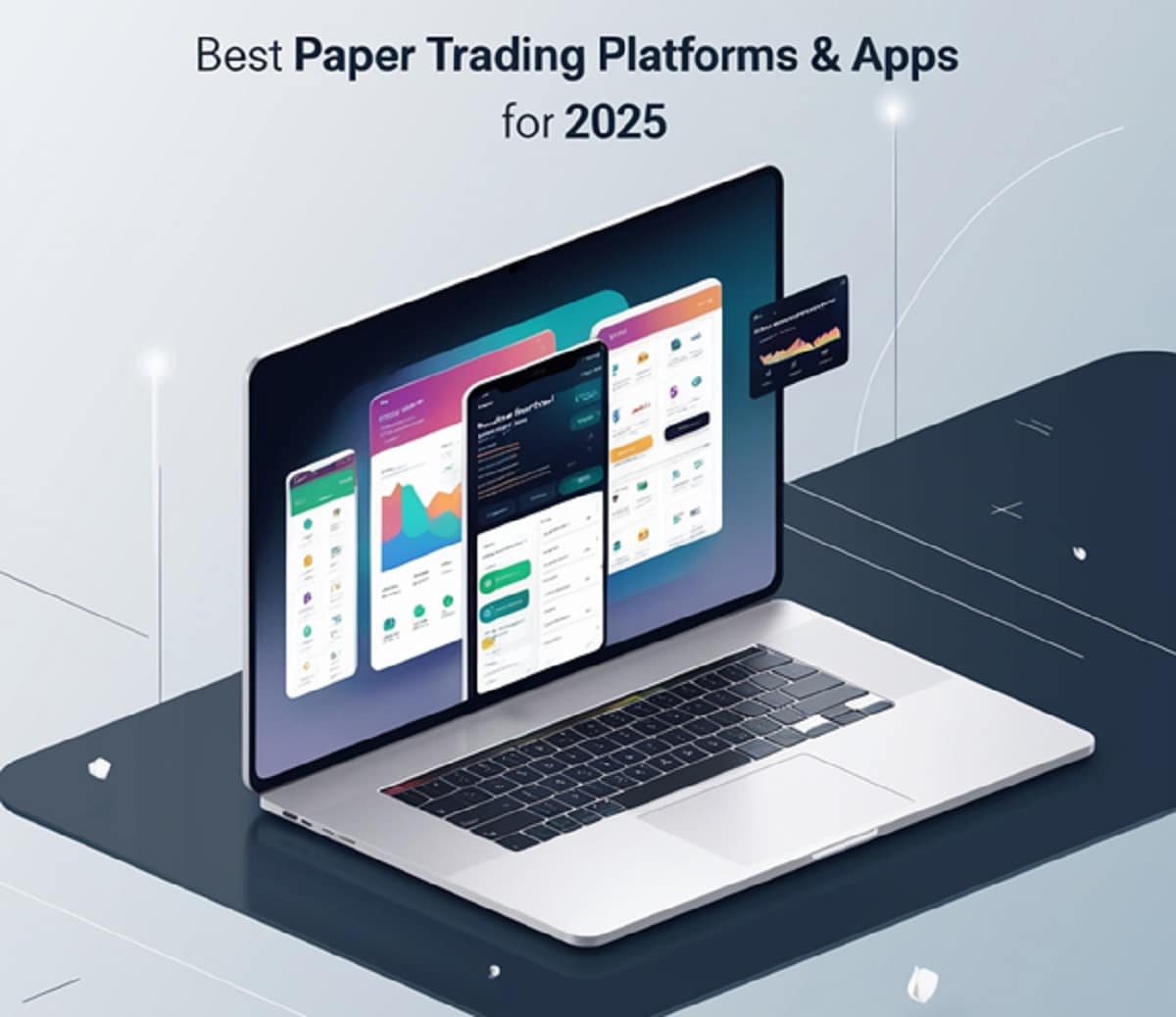Struggling to test out trading strategies with your own money? Learn what are the most recommended paper trading platforms and apps for 2025, so you can test your strategies without any risk and improve your skills.
Introduction
Lack of prior experience and going into trading blindly means unnecessary financial risk. This explains why paper trading platforms and apps are so essential. With these resources, you can play around with trading techniques in a realistic simulation, never having to worry that any losses on the account are not paper-only at all. For both newbies and old hands, the best paper trading websites and apps for 2025 also create a secured environment to practice your skills without any financial risks. In this guide, we’ll also mention leading platforms, unique features, and provide advice on how to choose the best option for your trading preferences.
Understanding Paper Trading
Simulated trading, or paper trading, allows the traders the possibility of trading without money, virtually. Users get to experiment with their strategies and observe market dynamics in a risk free environment where they gain confidence without risking any real money. Live trading puts you in real market conditions, while paper trading does the same but in a risk-free environment, suitable for those unfamiliar with trade.
Paper trading is an important process, even for seasoned traders who can utilize it to practice new ways, create their trading plans, and become accustomed to how to deal with different market situations without risking their capital. Mastering the basics of paper trading and understanding the advantages of this trading style makes the first step towards building trading skills.
Criteria for Choosing the Best Paper Trading Platforms
Selection of a correct paper trading app or platform is very important in making sure that you learn something practical. It is possible that the characteristics of each platform can be different and in this way you should find out what is important to you.
Simple layout is essential to new starters because navigation should be simple and straightforward. Through real-time operation, platforms allow to reproduce real live trading scenarios, making practicing more relevant and realistic. The capacity to trade various asset classes i.e stocks, cryptocurrencies, forex, and commodities, provides you with many learning opportunities.
Tutorials, guides, and webinars educational resources, can help you enormously to study. It is possible to use the platform from mobile devices, which allows you to trade virtually anywhere and anytime, and strong security functions ensure the security of private data. These will take you in the right direction in selecting your platform to meet your needs and your trading interests.
Top 10 Best Paper Trading Platforms & Apps for 2025

Venturing within the large selection of paper trading platforms and applications in 2025 can be overwhelming. In order to save you some time and make it easier for you, we have narrowed the list down to the top 10 most exceptional platforms that have an excellent feature, user-friendly design, and lifelike trading platforms.
There are no rigid categories on our list as each of our listed platforms offers services for both stock, forex, and commodity traders as well as for those interested in the cryptocurrency market. All the platforms have been evaluated through the lenses of such criteria as the reliability of the real-time data, usability, assets available, educational resources accessibility and general security.
Our offering supports not only new players, who can benefit from elementary interfaces, but also experienced traders, who can take advantage of sophisticated solutions, providing opportunities for no-risk practice and development.
- Thinkorswim by TD Ameritrade
- TradingView
- Webull
- eToro
- NinjaTrader
- Investopedia Simulator
- Interactive Brokers
- TradeStation
- Plus500
- MetaTrader 4/5
Comparative Analysis of the Listed Platforms
Review of an in-depth comparison of leading paper trading platforms or apps is easier to make when deciding what to use for paper trading. In this article, we compare the top platforms presented in this guide, paying attention to the main features, pricing plans, the types of available assets, mobile accessibility, and general user opinions.
With such a simple comparison, one can easily see which platform will suit your tendencies by choosing one with good navigation, or by choosing one capable of advanced trading. This realization enables you to select the most appropriate platform for your objectives and guarantees your investment will target the best solution for your needs.
How to Start with Paper Trading (Step-by-Step Guide)
The process of initiating paper trading isn’t difficult but the right actions can make you master the use of time and learning. It would be an excellent idea to choose a platform that fits your trading style – whether you’re looking to transfer stocks, currencies, or digital assets. Create a user account if a user account is available free of charge then move to the simulated or the practice trading platform.
Check out the primary features of the platform, including graphical tools, order methods, and instructional materials. First, perform simple trades to understand the simplicity behind trading and purchase and as you become more confident, develop sophisticated trading methods. Carry on your performance, review your gains and your losses, and make some adjustment to your plan as may be necessary. Understand that the point of paper trading is to build up trading knowledge and discipline rather than to make phony profit.
Mistakes to Avoid in Paper Trading
Although paper trading is meant to be an inherent safe mechanism of enhancement of skills, many traders experience common mistakes that can bog down development. Approaching paper trading with a ‘lame-brained’ attitude and not as a key learning tool can never be a good idea. Therefore, they are often tempted to speculate, which wouldn’t exist with live trading stakes. Many traders ignore risk management and since it’s a test environment with no monetary consequence, they might develop bad habits that would cause large problems in live trading.
Trading without a clear strategy may inspire traders with a false sense of ability. In addition, traders can sometimes be so smitten by the ease of paper trading that they stall on moving into live markets and so evade being exposed to actual market conditions. Once you realize that you can’t get as much information if you don’t maximize your learning from the paper trading, treat it as a useful simulation, make the discipline part of your life, and compare trading results regularly.
Advanced Tips for Making the Most of Paper Trading
Once you know your paper trading basics well begin exploring advanced strategies to further sharpen your trading skills. First, try out several order types such as stop-loss, limit and trailing stop, as they help you to take care of your trades and increase your earnings. Experiment with different trading styles such as day trading, swing trading and long-term investing to find which mode of style best compliments your style for trading.
Record every trade in your journal, indicating your drivers and end results, this will help you in reflecting on your progress and shall help in development. Save time to train your trading psychology, learn self-discipline, patience, and emotional management as if it were real life markets. Apart from that, constantly practice your trading acumen by doing it under different market circumstances, such as volatile and bearish, which will increase mental preparedness.
Conclusion
Summed up, paper trading is a rich tool for traders at any stage and enables them to work on their strategies and make them perfect prior to live trading, without the risk of financial exposure. Choosing high quality paper trading platforms and apps for 2025 will enable you to copy the actual trade environment, improve skills, and develop the competence necessary to trade for real.
At your stage, whether you are experimenting with interesting approaches to solve an issue, learning some fundamentals, or are capability-building to perfect your strategy, paper trading is an effective and safe way to increase your understanding of trading. As you advance, do not let paper trading take you longer, but as the bridge to real-market trading. Start your game now, to have a solid foundation towards future trading success.
FAQ: Best Paper Trading Platforms & Apps for 2025
Is paper trading free?
Most paper trading platforms offer free demo accounts, but some may charge for premium features or advanced tools.
Can I use the same strategies in live trading after paper trading?
Yes, the strategies you test in paper trading can be applied in live trading, but it’s important to consider the emotional aspect of real money trading.
How realistic is paper trading compared to real trading?
While paper trading mimics real-market conditions, it doesn’t fully replicate the psychological pressure of trading with real money, which is crucial for success in live markets.
How long should I paper trade before switching to live trading?
The duration depends on your comfort level and confidence. It’s essential to feel confident with your strategies and manage risk before transitioning to live trading.
Can I lose money in paper trading?
No, since paper trading uses virtual funds, you can’t lose real money, but it’s still important to practice proper risk management to prepare for real trading scenarios.
































